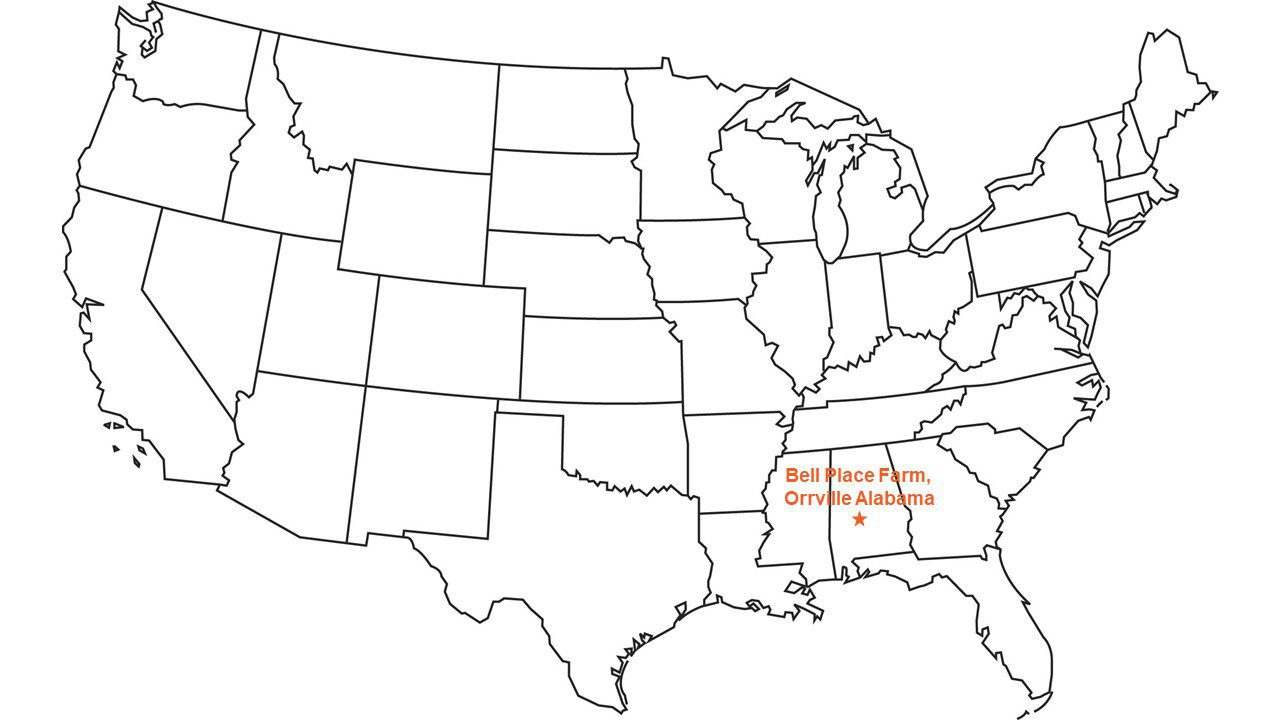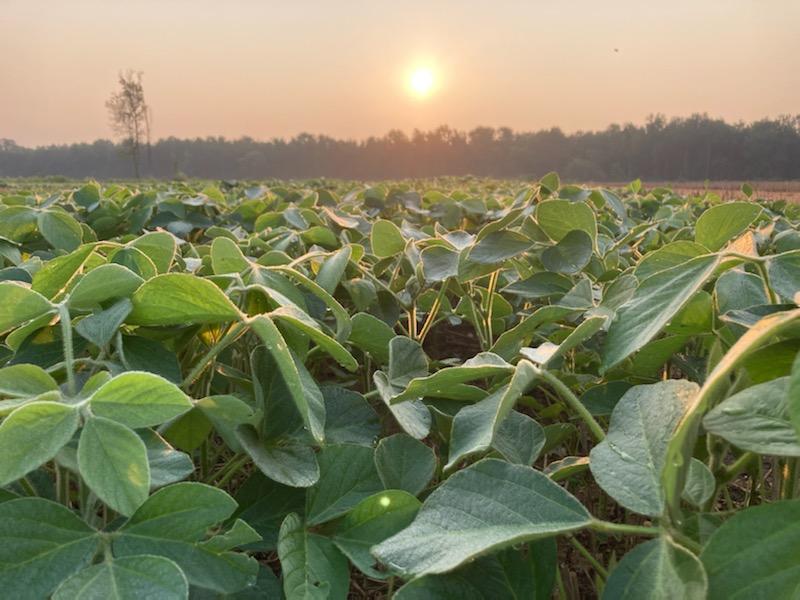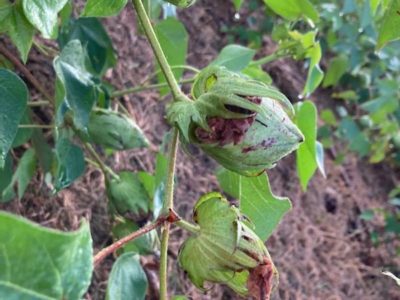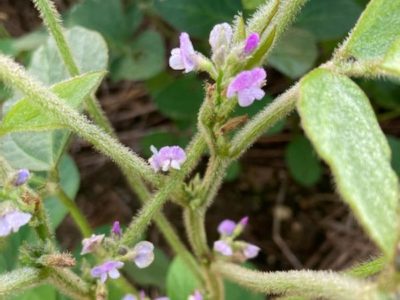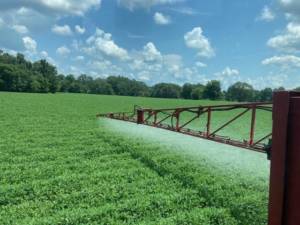 It’s the time of year when diseases and insects invade our growing crops. All the crops are growing well and we are currently looking good in the neighborhood. Our wet spring delayed planting so that we were about two weeks behind our average timing, but extreme heat in late July and early August have increased the growing degree days in our area of the southern U.S. The crops have almost gained back those two weeks they were behind. Thankfully, we’ve had timely rains, as well, so our crops are surging in maturity, catching up to what we consider to be average for this time of year.
It’s the time of year when diseases and insects invade our growing crops. All the crops are growing well and we are currently looking good in the neighborhood. Our wet spring delayed planting so that we were about two weeks behind our average timing, but extreme heat in late July and early August have increased the growing degree days in our area of the southern U.S. The crops have almost gained back those two weeks they were behind. Thankfully, we’ve had timely rains, as well, so our crops are surging in maturity, catching up to what we consider to be average for this time of year.
We have been watching closely to see what problems show up in our fields. We work closely with a crop scout, who helps us monitor our beneficial insects and diseases. We let the beneficials hold back the bad bugs as long as possible. But when we reach a threshold with insects that damage our crops, we treat to protect our crops. We take a similar approach with diseases.
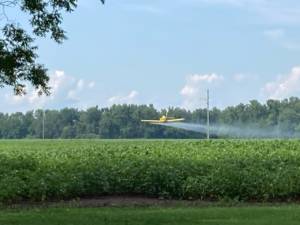 For example, we applied fungicide to our single-crop soybeans at the beginning of August, two weeks earlier than planned, because frog-eye leaf spot was becoming a problem. This disease causes defoliation, reducing photosynthesis and making it much harder for the soybean plants to fill pods. At the same time, we included an insecticide because a variety of worms and tiny insects were becoming a problem. The pest list included fall armyworms, loopers and velvet bean caterpillars, as well as an invasion of three-cornered alfalfa leaf hoppers and kudzu bugs. These pests eat leaves, flowers and girdle limbs, contributing to decreases in yield. We hired the airplane to apply the fungicide and insecticide combination, and the plants are happy now, with pods ranging in length from 1.25 to 4 cm, or .5 to 1.5 inches.
For example, we applied fungicide to our single-crop soybeans at the beginning of August, two weeks earlier than planned, because frog-eye leaf spot was becoming a problem. This disease causes defoliation, reducing photosynthesis and making it much harder for the soybean plants to fill pods. At the same time, we included an insecticide because a variety of worms and tiny insects were becoming a problem. The pest list included fall armyworms, loopers and velvet bean caterpillars, as well as an invasion of three-cornered alfalfa leaf hoppers and kudzu bugs. These pests eat leaves, flowers and girdle limbs, contributing to decreases in yield. We hired the airplane to apply the fungicide and insecticide combination, and the plants are happy now, with pods ranging in length from 1.25 to 4 cm, or .5 to 1.5 inches.
Our double-crop soybeans are starting to bloom, and they also look really good. We applied grass herbicide and foliar nutrients to them in early August. The herbicide eliminated weed competition. The nutrients supplemented the nutrients available in the soil, because they are the second crop growing in those fields this season.
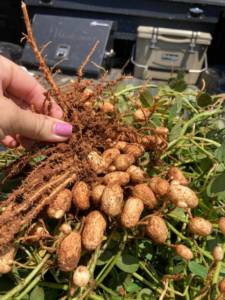 The peanuts continue to bloom and peg, sending out stems from the flowers that grow into the ground, that ultimately develop into the peanuts. This crop is very susceptible to disease, so to keep it healthy, we apply a fungicide to it every two weeks with our ground sprayer. The peanuts that have developed so far are clean, without any sign of disease, and already are a good size. That’s promising for this year’s crop.
The peanuts continue to bloom and peg, sending out stems from the flowers that grow into the ground, that ultimately develop into the peanuts. This crop is very susceptible to disease, so to keep it healthy, we apply a fungicide to it every two weeks with our ground sprayer. The peanuts that have developed so far are clean, without any sign of disease, and already are a good size. That’s promising for this year’s crop.
The cotton has grown to a size that allows the branches to grow toward the center of the rows, which we refer to as “lapped,” so we are staying out of the fields with the ground sprayer to prevent unnecessary damage from the sprayer wheels breaking branches or knocking off bolls. We hope to put wheel shields back on our sprayer this winter so we can do more of this spraying ourselves in the future. To keep our crop focused on its best yield potential, we have the airplane making an aerial application of a plant growth regulator every week to 10 days. It moves the plants from vegetative to reproductive growth. Those applications also include boron, a nutrient that helps the cotton during fruiting, when the bolls develop.
Fall armyworms started invading our double-crop sorghum, too. We hoped a good rain would drown them, but we didn’t get enough rain to wash them away. We treated those fields with insecticide, and the crop is starting to look very good. We are hoping to finish out the growing season for this crop with minimal spraying.
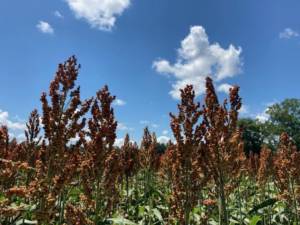 The single-crop sorghum is maturing quickly, so we desiccated it in mid-August. I applied glyphosate with our ground sprayer to stop plant growth and allow the crop to dry out. I expect it to be ready for harvest by the beginning of September. That will mark the start of a long, busy harvest season for all our crops that will last through December, ending with the completion of drilling our winter wheat.
The single-crop sorghum is maturing quickly, so we desiccated it in mid-August. I applied glyphosate with our ground sprayer to stop plant growth and allow the crop to dry out. I expect it to be ready for harvest by the beginning of September. That will mark the start of a long, busy harvest season for all our crops that will last through December, ending with the completion of drilling our winter wheat.
With harvest quickly approaching, I have continued shipping our winter wheat. The local mill has bought what they want, so I am looking for other nearby buyers. I don’t want to store the wheat for very long to avoid needing to treat the storage bin for bugs. Plus, I would like to get that bin cleaned out and prepared to hold other crops this fall.
In mid-August, had a unique meeting. I met with a local father-daughter team of beekeepers. They approached us to ask about keeping some hives on our farms. As farmers, we understand the importance of bees, and I have seen research noting that honeybees can increase soybean yields, and we will soon see for ourselves. I learned that some soybean nectar can possibly sweeten the flavor of the honey. I shared our specific soybean varieties, and they will check to see what varieties they prefer and if they could possibly provide a benefit for their honey production. They are installing some of their hives now, and we will work with our crop scout on recommendations to protect those hives when we must treat fields with insecticides, as we don’t want to harm the bees!
 Our crop rotation doesn’t give us much downtime during the growing season. In late July, my husband Jamie and I managed to attend an industry meeting together for his job as a brief break. It was unfortunate that he returned to the farm to start spraying soybeans and peanuts, while our daughters and I spent a few days with a friend on the coast of the Gulf of Mexico. The girls started school on August 9, and I am attending another industry meeting the last week of August for the Soy Nutrition Institute. After that, my focus will be on harvest and fall fieldwork. The season really is flying by! I’m sure our next update will involve some photos from my favorite seat, the combine. Until next time!
Our crop rotation doesn’t give us much downtime during the growing season. In late July, my husband Jamie and I managed to attend an industry meeting together for his job as a brief break. It was unfortunate that he returned to the farm to start spraying soybeans and peanuts, while our daughters and I spent a few days with a friend on the coast of the Gulf of Mexico. The girls started school on August 9, and I am attending another industry meeting the last week of August for the Soy Nutrition Institute. After that, my focus will be on harvest and fall fieldwork. The season really is flying by! I’m sure our next update will involve some photos from my favorite seat, the combine. Until next time!
This field update is funded by the soybean checkoff. To share or republish part or all of this Ground Work 2021 article, please link to the original article and credit www.USSOY.org.
